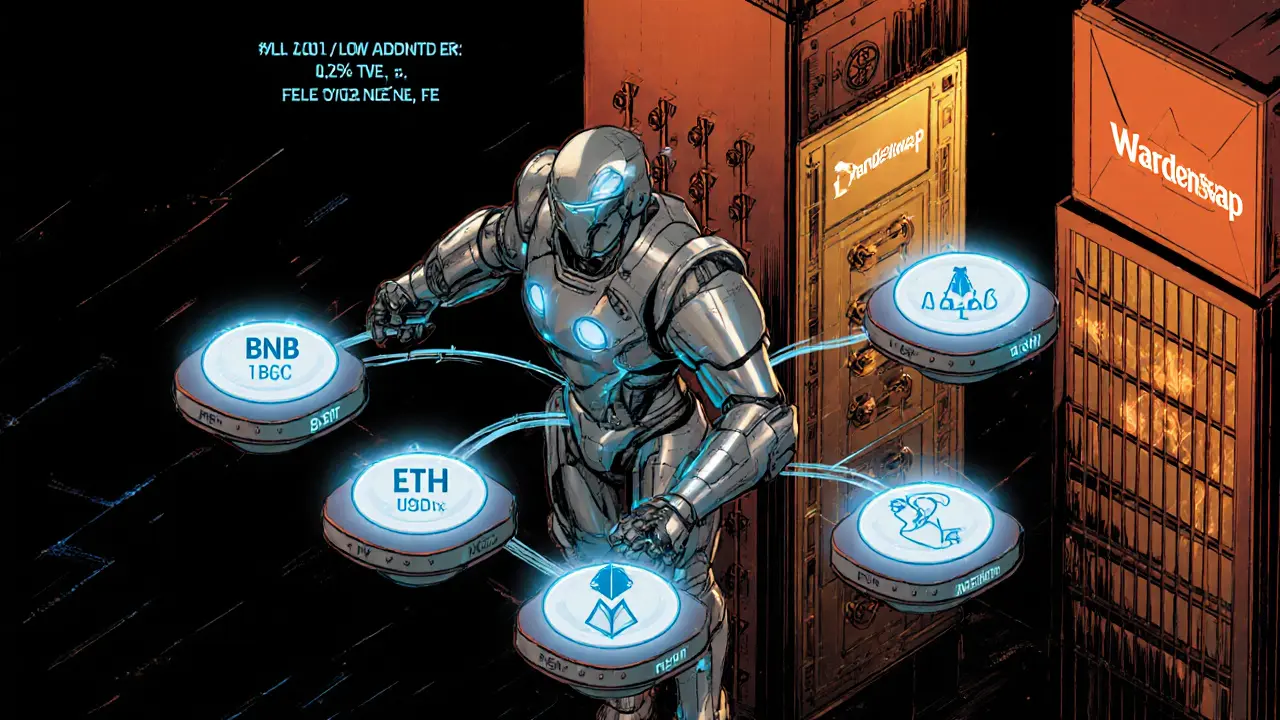WardenSwap Cross-Chain Swap Simulator
Input Token
Output Token
Important Note
This simulator estimates potential outcomes based on current WardenSwap data points and assumptions. Actual results may vary significantly due to:
- Real-time liquidity changes
- Network congestion and gas fees
- Slippage fluctuations
- Bridge fees for cross-chain transfers
When it comes to decentralized trading, WardenSwap is a multi‑chain decentralized exchange (DEX) that aggregates liquidity across Binance Smart Chain, Polygon, Ethereum and several layer‑2 solutions. The platform markets itself as the place where you’ll get “much better prices” than on competing DEXs, but the lack of user reviews, limited public data and a modest token outlook raise a lot of questions. This review breaks down what the protocol actually does, how it stacks up against the big players, and what risks you should weigh before sending any funds.
Quick Take
- WardenSwap offers cross‑chain swaps on BSC, Polygon, Ethereum and L2s, but trading volume is barely visible.
- The native WAD token is trading around €0.009 with a 2026 price target of €0.01 - modest growth expectations.
- No security audits are publicly posted, and the platform has zero user reviews on major aggregation sites.
- Compared to Uniswap, PancakeSwap and 1inch, WardenSwap’s fee structure is similar but its liquidity and TVL appear far lower.
- Extreme due‑diligence is a must; treat it as a high‑risk experiment rather than a core trading venue.
What Is WardenSwap and How Does It Claim to Beat Other DEXs?
WardenSwap positions itself as a rate‑optimising DEX. By pulling liquidity from multiple chains, it says you’ll receive a better exchange rate than you would on a single‑chain platform. The protocol’s smart contracts live on several blockchains, and a router contract determines the optimal path for each swap - essentially acting like an on‑chain aggregator.
The architecture relies on Binance Smart Chain (BSC), Polygon and Ethereum, plus a handful of layer‑2 rollups. When you request a trade, the router queries liquidity pools across these networks, calculates expected slippage, and executes the path with the lowest total cost.
From a user‑experience standpoint, the web UI is a single page where you select the input token, the output token, and the desired chain. The interface automatically connects to a Web3 wallet (MetaMask, Trust Wallet, etc.) and shows an estimated price before you confirm. No KYC is required because it’s a pure DEX.
Token Economics - The Role of WAD
The only on‑chain asset tied to the platform is the WAD token. It follows an ERC‑20 standard on Ethereum and a BEP‑20 version on BSC. According to price‑tracking sites, WAD trades around €0.009 today, with a 2026 forecast of €0.01 - roughly a 5% upside. The token’s utility is limited to governance proposals (if any) and occasional fee rebates. There is no public token‑distribution schedule, and the circulating supply hovers near the total supply, meaning price appreciation would have to come from genuine demand for the DEX itself.
Because the token does not power a robust incentive layer (e.g., liquidity mining rewards, staking yields), its market performance is closely tied to the platform’s adoption - which, as we’ll see, is still very thin.
Security, Audits, and Regulatory Outlook
Security is the biggest red flag. The project’s GitHub repository (wardenswap/warden-protocol) shows regular commits, but there is no publicly available third‑party audit report. In the DeFi world, a missing audit is a sign that the code has not been independently vetted for common vulnerabilities such as re‑entrancy, flash‑loan attacks, or faulty cross‑chain bridges.
Regulators have begun scrutinising DeFi protocols, especially those lacking clear governance and transparency. While WardenSwap is not listed on any sanctions or scam watchlists, the absence of audit documentation and the zero‑review rating on FxVerify signal a higher risk profile. Users should consider employing a hardware wallet, limiting trade size, and testing with a small amount before committing larger sums.

Competitive Landscape - How Does It Stack Up?
To understand WardenSwap’s value proposition, we compare it against three of the most established DEXs: Uniswap, PancakeSwap and 1inch. The table below summarises key metrics that traders usually care about.
| DEX | Supported Chains | Average Fee | Typical Slippage | Total Value Locked (USD) |
|---|---|---|---|---|
| WardenSwap | BSC, Polygon, Ethereum, L2s | 0.30% | 0.2% - 0.5% | ~$12M (estimated) |
| Uniswap | Ethereum, Optimism, Arbitrum | 0.30% | 0.1% - 0.3% | $6B |
| PancakeSwap | BSC, BNB Chain | 0.25% | 0.1% - 0.4% | $1.2B |
| 1inch | Ethereum, BSC, Polygon, Avalanche | 0.15% - 0.30% | 0.05% - 0.25% | $400M |
Notice the stark difference in TVL - WardenSwap’s estimated $12M is a fraction of what Uniswap or PancakeSwap lock. Lower liquidity often means higher price impact for sizable trades, which directly contradicts the platform’s “best rate” claim.
User Experience, Community, and Adoption Signals
Community engagement is a good proxy for a DEX’s health. On major aggregator sites like FxVerify, WardenSwap registers a 0‑star rating based on zero reviews. Social media activity (Twitter, Discord, Reddit) is sporadic at best, with the last notable post appearing over six months ago. By contrast, Uniswap and 1inch maintain active developer channels, regular AMAs, and transparent governance proposals.
From a practical standpoint, you can perform a swap in under a minute, but you’ll need to manually approve each token’s contract on every chain you touch. The UI does not presently offer gas‑fee optimization tools, and there’s no built‑in analytics dashboard to track your past trades.
Pros, Cons, and Quick Checklist
- Pros
- Cross‑chain swapping without leaving the UI.
- Transparent, open‑source code on GitHub.
- Low standard DEX fee (0.30%).
- Cons
- Very low TVL and liquidity depth.
- No public security audit or formal bug‑bounty program.
- Zero user reviews - community trust is minimal.
- WAD token offers limited utility and modest upside.
For anyone who values a proven track record, the cons outweigh the novelty of multi‑chain swapping.
Final Verdict - Should You Trade on WardenSwap?
If you’re an experiment‑loving DeFi nerd who wants to test cross‑chain paths with a few dollars, WardenSwap can be a sandbox. But for regular trading, liquidity provision, or large‑scale swaps, the platform’s thin market depth, lack of audits and missing community feedback make it a high‑risk choice.
In practice, keep the majority of your assets on well‑audited DEXs or centralized exchanges that provide insurance and clear support. Use WardenSwap only after you’ve done a test‑trade with a small amount, monitored the transaction on a block explorer, and are comfortable with the smart‑contract code.
Frequently Asked Questions
Is WardenSwap safe to use without a security audit?
Without an independent audit, you cannot be sure the contracts are free of vulnerabilities. Treat the platform as high risk and limit exposure.
How does the WAD token earn me any benefits?
Currently WAD provides only occasional fee rebates and possible governance voting rights. There is no active staking or liquidity‑mining program.
Can I swap directly from BSC to Polygon on WardenSwap?
Yes. The router routes the trade through its cross‑chain bridge contracts, but you’ll pay bridge fees on top of the standard DEX fee.
What is the typical slippage I should expect?
Because liquidity is low, slippage can range from 0.2% to 0.5% for midsize trades. Larger orders may see higher price impact.
How can I verify the code myself?
All smart‑contract source files are public on the GitHub repository. You can download, compile, and run a local test‑net simulation to inspect the routing logic.



Debby Haime
February 3 2025WardenSwap looks promising, especially with its cross-chain capability. If you test with small amounts, you’ll get a feel for the liquidity and actual slippage. The UI is clean enough for newcomers yet has enough depth for seasoned traders.
katie littlewood
February 4 2025In my experience, a platform that truly embraces multi‑chain dexing must first win our trust through transparency, and that’s where WardenSwap tries to make its mark. The simulator is a neat touch, giving users a sandbox to gauge potential outcomes before committing real capital.
However, the devil is in the details – bridge fees can silently eat away at your returns, and those can fluctuate wildly depending on network congestion.
One must also keep an eye on the underlying liquidity pools; shallow depth can cause brutal slippage, especially when swapping sizable sums across chains.
That said, the UI feels polished, with intuitive token selection dropdowns and clear chain icons that reduce friction for beginners.
The inclusion of a “test trade” reminder is a responsible move, acknowledging that real‑world conditions often diverge from simulator estimates.
On the flip side, the documentation could benefit from more granular breakdowns of how bridge fees are calculated, as many users are still figuring out why their received amount sometimes deviates from the on‑screen quote.
Another point worth noting is the gas cost on the source chain; even if the swap itself is cheap on BSC, a high Ethereum gas price can turn a seemingly profitable trade into a loss.
Security-wise, the platform appears to have undergone recent audits, but continuous monitoring is essential in this fast‑moving DeFi landscape.
Community feedback on Reddit and Discord suggests that the support team is responsive, which is a comforting factor when dealing with cross‑chain hiccups.
Overall, I’d say WardenSwap is a solid addition to the multi‑chain DEX arena, provided you stay vigilant about fees and pool health.
For those who are risk‑averse, start with sub‑$100 trades to calibrate the fee structure and slippage behavior.
If you’re comfortable with the inherent volatility, the ability to jump between BSC, Polygon, and Ethereum without leaving the platform is a genuine convenience boost.
In summary, treat the simulator as a compass, not a map; it points you in the right direction but you still need to navigate the terrain yourself.
Happy swapping, and may your trades be ever in the green!
Jenae Lawler
February 5 2025While the marketing narrative paints WardenSwap as a revolutionary cross‑chain conduit, one must critically assess whether it truly mitigates the pervasive issues of decentralised finance. The platform’s reliance on external bridges introduces a vector of risk that is often downplayed in promotional material. Moreover, the purported “low slippage” claims merit scrutiny in light of the limited liquidity across some of the less frequented token‑pair pools. It would be prudent for discerning participants to demand comprehensive audit reports, rather than accepting superficial assurances. In sum, the proposition, though superficially appealing, remains insufficiently substantiated.
Chad Fraser
February 5 2025Yo, I gave WardenSwap a spin and the cross‑chain swaps were surprisingly smooth. The gas estimator seems decent, and the UI keeps me from feeling lost. Definitely worth a try if you’re looking to diversify without juggling multiple wallets.
Jayne McCann
February 6 2025Honestly, it feels overhyped.
Richard Herman
February 7 2025From a cultural perspective, the ability to move assets across chains can democratise access to different DeFi ecosystems. However, users should stay mindful of the varying regulatory landscapes governing each chain, as this can affect compliance and tax obligations.
Parker Dixon
February 8 2025Great points, Richard! 👏 I’d add that testing with a modest amount is the safest route. Also, keep an eye on the bridge fee schedule, as it can differ dramatically between BSC ↔️ Polygon and BSC ↔️ Ethereum. 🙂
Stefano Benny
February 9 2025WardenSwap’s architecture is essentially a layered protocol stack that abstracts away the complexities of inter‑chain communication. Yet, the underlying oracle integration appears to be a single point of failure, which could be exploited for price manipulation.
Bobby Ferew
February 9 2025Even with all the fancy features, I’m still hesitant. The platform’s UI feels cluttered, and the fee breakdown isn’t as transparent as one would hope.
celester Johnson
February 10 2025One could argue that the superficial elegance of the interface masks deeper systemic vulnerabilities. In the grand tapestry of decentralized finance, the true measure of a DEX lies not in its sheen but in its resilience to adversarial pressures.
Prince Chaudhary
February 11 2025I respect the effort put into building WardenSwap. For newcomers, the simulator serves as a helpful learning tool, provided they remain cautious and verify actual outcomes with small test trades.
John Kinh
February 12 2025Sure, but honestly, I’m not convinced it’s worth the hassle. There are already established DEXs that do the job without the extra frills.
Mark Camden
February 13 2025From a regulatory standpoint, any platform facilitating cross‑chain transactions must adhere to AML/KYC standards across all jurisdictions involved. Failure to implement robust compliance mechanisms could expose both the platform and its users to legal ramifications.
Evie View
February 13 2025Regulation isn’t the only issue-look at the slippage on low‑liquidity pairs. It’s absurd how quickly your trade can be devoured by fees. This platform needs a serious overhaul.
Sidharth Praveen
February 14 2025Stay optimistic, folks! Even if the fees seem high now, the ecosystem is evolving fast, and we’ll likely see more efficient routing solutions soon. Keep experimenting and share your findings.
Sophie Sturdevant
February 15 2025Exactly, Sidharth-push the platform to improve its fee algorithm. If we collectively demand better performance, the developers will have no choice but to step up.